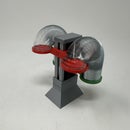Introduction: A 3D Printed Kinetic Marble Machine.
"A 3D Printed Kinetic Marble Machine" is a relatively easy to 3D print and assemble kinetic model featuring a two piece "print in place" dual axis gimbal mechanism. The model is constructed of ten unique 3D printed components (eleven total) and is very quiet. We find it pleasing to watch as the marble traverses the circular track and are awaiting grandkids approval!
Designed using Autodesk Fusion 360, sliced using Ultimaker Cura 4.12.1, and 3D printed in PLA on Ultimaker S5s.
Supplies
Soldering iron and solder.
Thick cyanoacrylate glue.
Double sided tape.
Step 1: Parts.
I acquired the following parts:
- One N20 6VDC 35RPM gear motor.
- One twin AAA switched battery case.
- Two AAA batteries.
- One 14mm plastic marble.
I 3D printed the following parts at .15mm layer height, 20% infill, and no supports unless noted otherwise:
- Two "Axle, Gimbal.stl".
- One "Base.stl".
- One "Battery Box Cover.stl".
- One "Battery Box.stl".
- One "Bolt (M8 by 1.25 by 8).stl".
- One "Cam, Motor.stl".
- One "Coupler.stl".
- One "Gimbal.stl".
- One "Mount, Track.stl".
- One "Track.stl".
This is a low precision 3D print and assembly model using at times very small precision 3D printed parts in very tight spaces. Prior to assembly, test fit and trim, file, sand, etc. all parts as necessary for smooth movement of moving surfaces, and tight fit for non moving surfaces. Depending on you printer, your printer settings and the colors you chose, more or less trimming, filing and/or sanding may be required. Carefully file all edges that contacted the build plate to make absolutely certain that all build plate "ooze" is removed and that all edges are smooth. I used small jewelers files and plenty of patience to perform this step.
The model also uses threaded assembly thus an M8 by 1.25 tap and die will assist with thread cleaning if necessary.
Attachments
Step 2: Base Assembly.
To assemble the base, I performed the following steps:
- Glued "Coupler.stl" into the inside of "Battery Box.stl".
- Glued "Base.stl" to the assembly.
- Turned the batter case switch off, removed the battery case cover, inserted two AAA batteries into the battery case, then replaced the cover.
- Ran the battery pack wires up through the battery box, coupler and base then soldered the wires to the gear motor.
- Attached the switched battery case to "Battery Box Cover.stl" using double sided tape making certain the battery case switch was accessible via the bottom of the cover.
- Pressed the motor into the assembly.
- Pressed "Cam, Motor.stl" onto the motor shaft.
- Pressed the battery box cover onto the assembly.
Step 3: Gimbal Assembly.
To assemble the gimbal, I performed the following steps:
- Pressed "Mount, Track.stl" into "Gimbal.stl".
- Pressed "Track.stl" onto the track mount and secured in place with "Bolt (M8 by 1.25 by 8).stl".
Step 4: Final Assembly.
For final assembly, I performed the following steps:
- Positioned the gimbal assembly between the towers of the base assembly and onto the cam motor pin.
- Secured the gimbal to the base assembly using two "Axle, Gimbal.stl".
With final assembly complete, I turned on the battery case switch, placed the model on a level surface, placed the "marble" onto the track, and off it went!
And that is how I 3D printed and assembled "A 3D Printed Kinetic Marble Machine".
I hope you enjoyed it!























